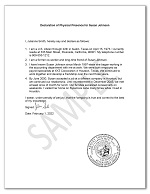
Individuals born outside the United States to at least one U.S. citizen parent may already be U.S. citizens at birth. However, they generally must apply for a Certificate of Citizenship using Form N-600 to obtain official proof. One of the most important steps in this process is meeting the Form N-600 physical presence requirements — proving that the U.S. citizen parent spent the required amount of time physically present in the United States before the child's birth.
This guide explains the importance of proving physical presence for an N-600 application and provides a list of documents that can help establish eligibility.
Understanding Form N-600 Physical Presence Requirements
The laws governing the transmission of U.S. citizenship vary based on the date of the child's birth. However, in most cases, a U.S. citizen parent must meet a minimum physical presence requirement before passing citizenship to a child born abroad. Under current immigration law, one of the following conditions must be true:
- If both parents were U.S. citizens at the time of the child’s birth: At least one parent must have resided in the United States at any time before the child was born.
- If one parent was a U.S. citizen and the other was a U.S. national: The U.S. citizen parent must have been physically present in the U.S. for at least one continuous year before the child's birth.
- If one parent was a U.S. citizen and the other was a foreign national: The U.S. citizen parent must have been physically present in the U.S. for at least five years, including at least two years after the age of 14.
To confirm eligibility, applicants must provide documentation proving the U.S. citizen parent’s presence in the country. These requirements change for children born out of wedlock and for children born before November 14, 1986.
Documents That Help Prove Physical Presence for N-600 Application
When filing Form N-600, Application for Certificate of Citizenship, the applicant must include evidence demonstrating that their U.S. citizen parent met the required physical presence period. Strong evidence includes official records and other verifiable documents.
Primary Evidence
Primary evidence includes records and other documentation that directly proves a fact. Examples of evidence that can help prove a parent meets the N-600 physical presence requirements include:
School Records
Transcripts, diplomas, or report cards showing enrollment in U.S. schools.Employment Records
Pay stubs, tax returns, W-2 forms, or employer verification letters.Military Service Records
Official military records indicating time served in the U.S. armed forces.Housing and Utility Bills
Mortgage or lease agreements, utility bills, and other proof of residence.Medical Records
Vaccination records, hospital bills, or doctor’s visits.Baptismal Certificates or Church Records
Documents showing the parent's involvement in a religious institution.Travel Records
Passport stamps or airline tickets demonstrating time spent in the U.S.Official Correspondence
Letters or documents from religious organizations, unions, or clubs verifying the parent’s participation.Social Security Statements
A Social Security earnings record showing work history in the United States.
Secondary Evidence
You may also use affidavits from credible witnesses having a personal knowledge of your parent’s physical presence or residence in the United States. Although you may submit affidavits, you should provide some type of additional evidence to support the application. Affidavits are generally viewed as secondary evidence that don’t carry as much weight as other primary evidence listed in the section above. They’re appropriate to corroborate primary evidence. For example, an affidavit that provides testimony from someone who attended school with your parent is a great way to corroborate a school registration for the same school.
Sample Affidavit for N-600 Physical Presence Requirement
An affidavit is a notarized, written statement. The person who writes an affidavit swears to its truth and may be required to testify before an immigration officer in rare cases. The affidavit must include the following information:
- Person's full name, address, date and place of birth and immigration status
- General statement about how they know the U.S. citizen parent (i.e. friend, co-worker)
- Date when they first met the parent, where they met, and through what context they met (i.e. church, professional, etc.)
- Statement of their relationship with the parent and how frequently they saw them during this period (i.e. monthly)
- Date and signature
The affidavit should be notarized. It’s also important to include a statement that swears to the statement’s validity, “I swear, under penalty of perjury, that the foregoing is true and correct to the best of my knowledge.”
Remember, use the affidavit to support other primary evidence that your parent was physically present in the United States during the requisite time periods.
For individuals seeking proof of U.S. citizenship through their parents, proving physical presence for an N-600 application is a key step. By understanding the requirements and compiling the right evidence, applicants can strengthen their case and secure their Certificate of Citizenship.
For additional guidance, consider using CitizenPath’s easy-to-follow service to ensure a smooth and successful application process.
How CitizenPath Helps with Form N-600
Gathering the necessary documents to meet Form N-600 physical presence requirements can be challenging. CitizenPath simplifies the process with a step-by-step online service designed to help applicants prepare a strong case. Our platform ensures that applicants complete their Form N-600 accurately, reducing the risk of delays or denials. We also provide personalized filing instructions based on individual circumstances.
In fact, CitizenPath provides simple, affordable, step-by-step guidance through USCIS immigration applications. Individuals, attorneys and non-profits use the service on desktop or mobile device to prepare immigration forms accurately. Explore support for the Citizenship Certificate Package (Form N-600) and several other immigration forms.
Want more immigration tips and how-to information for your family?
Sign up for CitizenPath’s FREE immigration newsletter and
SAVE 10%
on our immigration services







